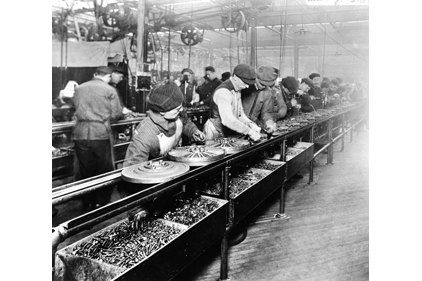Ford Motor Co. and Toyota Motor Corp., the two companies that pioneered mass production and lean manufacturing, are each celebrating important milestones this year. Ford is marking the 150th anniversary of the birth of Henry Ford and the 100th anniversary of the assembly line. Meanwhile, Toyota is celebrating its 75th anniversary and the 100th anniversary of the birth of Eiji Toyoda, the former president and chairman of the automaker who spearheaded its global expansion efforts in the 1970s and 1980s.
this year. Ford is marking the 150th anniversary of the birth of Henry Ford and the 100th anniversary of the assembly line. Meanwhile, Toyota is celebrating its 75th anniversary and the 100th anniversary of the birth of Eiji Toyoda, the former president and chairman of the automaker who spearheaded its global expansion efforts in the 1970s and 1980s.
In their early days, both Ford and Toyota used innovation to achieve production breakthroughs that quickly propelled them to success—the moving assembly line and just-in-time manufacturing.
Henry Ford was born on July 30, 1863, on a farm in Dearborn, MI. As most people know, Ford’s big contribution was the moving assembly line (contrary to popular belief, he did not invent it—Ford merely assembled a team of engineers who collaborated on the project).
The first moving assembly line for a large-scale manufacturing application began to operate on April 1, 1913, at Ford’s Highland Park, MI, plant, which was producing the Model T. The manually operated assembly line was used to produce flywheel magnetos (a key component of the Model T’s electrical system).
A group of 29 operators pushed flywheels down a waist-high table constructed out of metal pipe frame and angle iron. As each flywheel was pushed from right to left, the assemblers attached and tightened various components. They reached into bins positioned underneath the line and grabbed V-shaped magnets, screws, nuts, washers, bolts and other parts. Fasteners were tightened with power-driven socket wrenches.
The new assembly process dramatically increased productivity. For instance, production time per flywheel was reduced from 20 minutes to 13 minutes. Soon after the manual line proved to be successful, Ford engineers developed a motorized version to increase throughput rates. Within a year, 14 assemblers were producing a flywheel every 5 minutes.
Four months later, Ford engineers created a crude assembly line in which a chassis was pulled 250 feet by rope and a hand-cranked windlass. Over the next four months, they experimented with the line and made numerous changes in speed, workstation positions and the number of assemblers. On Jan. 14, 1914, the assembly line became power-driven when Sorensen added an “endless chain” powered by a motor.
I have written several articles about this historical event in the past (see “The Man Behind the Moving Assembly Line” and “The Model T Turns 100”). And, we will be publishing a new article on the origins of Ford’s assembly line in the October issue of ASSEMBLY.
The innovation that transformed Toyota was just-in-time production—one of the core elements of the Toyota Production System. Kiichiro Toyoda, the founder of Toyota Motor Corp., proposed the concept when production of the Model AA sedan ramped up at the company’s first assembly plant in Koromo, Japan (today’s Toyota City) in 1938.
“I believe that the most important thing is to ensure that there is neither shortage nor excess,” said Toyoda, who had experimented with Ford’s concept of using chain-driven conveyors a decade earlier while serving as chief engineer and managing director of the Toyoda Automatic Loom Works. “That is, to ensure that there is no excess labor and time for the designated production. There is no waste and there is no excess. It means not having to wait for parts to be circulated around. It is important that each part be ready just in time. This is the first principle of increasing efficiency.”
“What Kiichiro had in mind was to produce the needed quantity of the required parts each day,” recalled Eiji Toyoda (Kiichiro’s cousin) in 1988. “To make this a reality, every single step of the operation, like it or not, had to be converted over to his flow production system. Kiichiro referred to this as the just-in-time concept. By this he meant ‘just make what is needed in time, but don't make too much.’”
However, the just-in-time concept was not fully realized at Toyota until 1954, when the supermarket supply method—the idea of having subsequent processes take what they need from the earlier processes—was developed. The kanban system was created as a tool for carrying this out. After a decade of development in other Toyota plants, company-wide adoption of the kanban system occurred in 1963.
Which innovation has had a bigger impact on the auto industry—the moving assembly line or just-in-time production?

